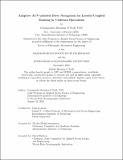Adaptive AUV-assisted Diver Navigation for Loosely-Coupled Teaming in Undersea Operations
Author(s)
O'Neill, Brendan
DownloadThesis PDF (19.70Mb)
Advisor
Leonard, John
Terms of use
Metadata
Show full item recordAbstract
Human divers face immense challenges in the undersea domain due to constraints on life support, sensory input, and mobility. Due to these challenges, even simple tasks are difficult, and navigation between points of interest is key among them. However, humans have progressively utilized creativity, innovation, and research to explore the Earth’s oceans at greater depths and with increased spatial and temporal detail. Autonomous underwater vehicles often lack the tools, dexterity, or flexibility to manage specific tasks or unforeseen circumstances. However, advances in inertial navigation, computation, and acoustic communication enable autonomous underwater vehicles to perform tasks outside human capability. Acoustic modem technology allows for flexible and reliable communication over an acoustic link. We propose algorithms for cooperative navigation between a diver and an autonomous underwater vehicle as a pathway toward complex undersea human-robot teams. This thesis identifies the communication, software, and algorithmic tools to enable loosely-coupled cooperative navigation between an autonomous underwater vehicle and a diver without a surface presence. Divers present new challenges for cooperative navigation based on their unique motion profile and variable pace from diver to diver. By leveraging the vehicle’s sensor suite, acoustic modem technology, and nonlinear least-squares state estimation, we enable enhanced diver localization and navigation without a surface presence. Adaptation to environmental impacts is explored through measured ocean currents as well as updates to the diver’s motion model based on state estimation analysis. These adaptations produce more efficient diver transits with fewer heading changes. In addition, maneuvering strategies for autonomous underwater vehicles are explored to assess their impact on diver localization accuracy. Experimental validation is shown through surface platforms as proxies for the autonomous underwater vehicle and diver, demonstrating the localization accuracy within a few meters for experiments under various operating conditions. These contributions provide a foundation for undersea human-robot teams to engage in complex tasks with greater efficiency through their combined strengths.
Date issued
2023-09Department
Massachusetts Institute of Technology. Department of Mechanical Engineering; Joint Program in Oceanography/Applied Ocean Science and EngineeringPublisher
Massachusetts Institute of Technology